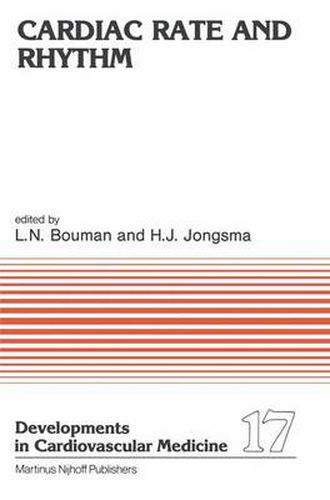Readings Newsletter
Become a Readings Member to make your shopping experience even easier.
Sign in or sign up for free!
You’re not far away from qualifying for FREE standard shipping within Australia
You’ve qualified for FREE standard shipping within Australia
The cart is loading…






This title is printed to order. This book may have been self-published. If so, we cannot guarantee the quality of the content. In the main most books will have gone through the editing process however some may not. We therefore suggest that you be aware of this before ordering this book. If in doubt check either the author or publisher’s details as we are unable to accept any returns unless they are faulty. Please contact us if you have any questions.
In the denervated state the mammalian heart, both in vivo and in vitro, is excited at very regular intervals, the coefficient of variance of the interbeat intervals not exceeding 2%. The pacemaker that is the source of this regular ex citation is localised normally within the sinus node ( sino-atrial node
node of Keith and Flack), a most intriguing small piece of tissue in the caval corner of the right atrium. A small portion of this node containing a group of probably only a few thousands of cells fires spontaneously, that means without any exter nal influence to trigger their activity. The so called pacemaker cells do this by letting their membrane potential fall to the level where an action potential will start which subsequently activates surrounding cells to fire an action po tential. The first question which is tackled in this book is which processes underly this spontaneous diastolic depolarization. This is discussed in section I, concerning the fundamental properties of pacemaker cells with special refer ence to ionic membrane currents. Although views still quite differ about the exact nature of the membrane processes that cause the automatic pacemaker dis charge there is agreement that diastolic depolarization is brought about by the interaction of a number of ionic current systems, including both inward and out ward going currents.
$9.00 standard shipping within Australia
FREE standard shipping within Australia for orders over $100.00
Express & International shipping calculated at checkout
This title is printed to order. This book may have been self-published. If so, we cannot guarantee the quality of the content. In the main most books will have gone through the editing process however some may not. We therefore suggest that you be aware of this before ordering this book. If in doubt check either the author or publisher’s details as we are unable to accept any returns unless they are faulty. Please contact us if you have any questions.
In the denervated state the mammalian heart, both in vivo and in vitro, is excited at very regular intervals, the coefficient of variance of the interbeat intervals not exceeding 2%. The pacemaker that is the source of this regular ex citation is localised normally within the sinus node ( sino-atrial node
node of Keith and Flack), a most intriguing small piece of tissue in the caval corner of the right atrium. A small portion of this node containing a group of probably only a few thousands of cells fires spontaneously, that means without any exter nal influence to trigger their activity. The so called pacemaker cells do this by letting their membrane potential fall to the level where an action potential will start which subsequently activates surrounding cells to fire an action po tential. The first question which is tackled in this book is which processes underly this spontaneous diastolic depolarization. This is discussed in section I, concerning the fundamental properties of pacemaker cells with special refer ence to ionic membrane currents. Although views still quite differ about the exact nature of the membrane processes that cause the automatic pacemaker dis charge there is agreement that diastolic depolarization is brought about by the interaction of a number of ionic current systems, including both inward and out ward going currents.